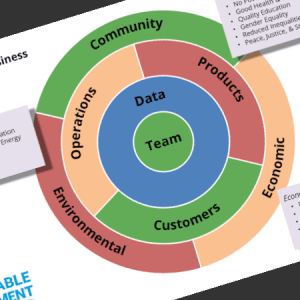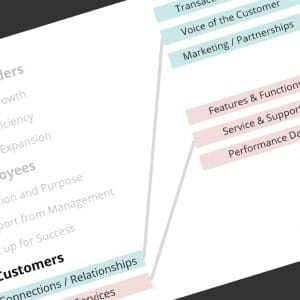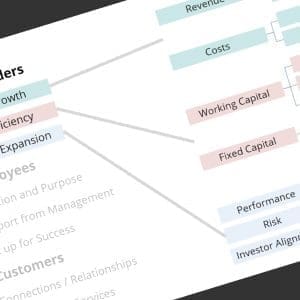A great place to start your digital journey - leveraging the skills, knowledge, and understanding of the information and technology that drives your internal operations. This is the first component of a Great Digital Business. (Part of a series)
In the first part of this series, I talked broadly about the Five Core Components of a Great Digital Business. Now it’s time to get a bit more specific, starting in an area that some think mundane; internal operations (woo hoo!) and the foundational system that drives it all – your ERP.
Heads up, now! Don’t think of this stuff as overcomplicated, expensive, and tedious processes that feel like a waste of time for everyone (except the bean counters). This stuff is foundational, even instructional, for the “sexier” components (… Mobile! … AI! … IoT! …) of your Great Digital Business conversation.
The Value of Automating Operations
This is not a recent idea – Michael Porter and Victor Miller wrote about this in 1985, during the heyday of the original “information revolution”. Back then, many firms went through their own Massive System Projects, automating every facet of internal operations – Order to Cash, Purchase to Pay, Make to Ship, and Record to Report. (Ah, that magical 80’s consultant-speak that made everything sound so formal … does it sound familiar?)
No one wants to remember the pain of their first (and often, last) ERP implementation. But it’s important to understand how your teams take advantage of this huge investment in time, money, and people. Are you focused solely on the tasks required to flow data cleanly to your general ledger, so you can efficiently close the month and update your financial statements within a few business days? It’s common for organizations to look on these processes as necessary evils – transactional overhead that gets in the way of great customer relationships.
But smart teams understand how these systems drive their business while making things much more observable and manageable. It’s the difference between people who know their jobs (the tasks required to get things done) and really understand their jobs (and how they can use information, transactions, and process to drive efficiencies and increased customer service).
The Link to Digital Business
Admittedly, the technology seems mundane and dated – an uninspiring front end to the boring transactional detail of daily commerce, a cost-of-doing-business in the modern world. But there is a great opportunity here, to leverage the organization’s knowledge and rigor around data quality, standard work, and transactional discipline for the other functional areas of your Great Digital Business.
- Customer Relationships: Organizations that are efficient and proficient with their ERP have known for years that the quality of the “master data” (chart of accounts, bills of materials, details of the item master, etc.) have a significant impact on making the business visible and enabling detailed insights. There is typically lots of process around the data required to Make and Ship your products … but what about the data required to Market and Sell? How can I implement e-catalogs and configuration tools that are truly helpful for my customers, without that same level of engineering rigor? It’s a significant new skill for the Sales and Marketing – but they don’t have to learn this in a vacuum.
- Products and Services: Adding information, analytics, and other data services as a new, highly profitable line item on a monthly invoice sounds simple. But what about all those “exception” processes like contract pricing, customer returns and exchanges, and even technical support? When you’re engineering, sales, customer service, and product support teams truly understand how everything hooks together in the ERP, they should bring huge value to the product development team that is trying to understand all the processing (and costs!) involved in such an offering.
- Leveraging Information: As ERP systems have successfully matured beyond the simple view of automating the general ledger, the best teams are using the information to identify costs and opportunities for the bottom line of the P&L. At this same time, planners are aggressively looking at the entire supply chain and distribution chain, looking for ways to optimize working capital and improve the balance sheet. These are powerful skills that can be transferred to the customer-facing and product line teams working in this new digital reality.
The Hidden Treasure
Actually, a bit of a “dirty secret” – but a truly valuable opportunity. As organizations develop skills, knowledge, and understanding (transactional discipline, data quality and governance), they build up a significant asset – the rich information in their internal systems.
And leveraging that rich information is a great place to start your digital journey – because to a great extent, your efforts will be hidden from prying, external eyes. You can (and will) make some mistakes along the way; yes, you might disappoint a few customers with missing components, late shipments, or other problems. But that is significantly better than screwing up the data in your e-commerce system and having it immediately published to the web for everyone to see. And wouldn’t you rather work out your sensor, communication, and data management problems with internal equipment – before you are impacting hundreds of customers with your product problems?
Start with the foundation of your internal operations – it’s familiar ground. But quickly expand your world view – what you do inside your four walls can inform and drive what you do with Customers and Products.
One of a series on Digital Business; next up is Digital Business and Customers …
.. but why wait to start the conversation? What are your questions or ideas on how systems and processes for Internal Operations can be part of a Digital Transformation? Join in the conversation with your Comments …
15 January, 2017
- The Five Core Components of a Great Digital Business
- Digital Business and Internal Operations: Treasure in the Foundation
- Digital Business and Customer Relationships: Big Value in Tight Connections
- Digital Business and Products: Changing the Game in a Big Way
- Digital Business and Data: The Critical Connective Tissue
- Digital Business and Your Team: Talent and Engagement







This Post Has 0 Comments